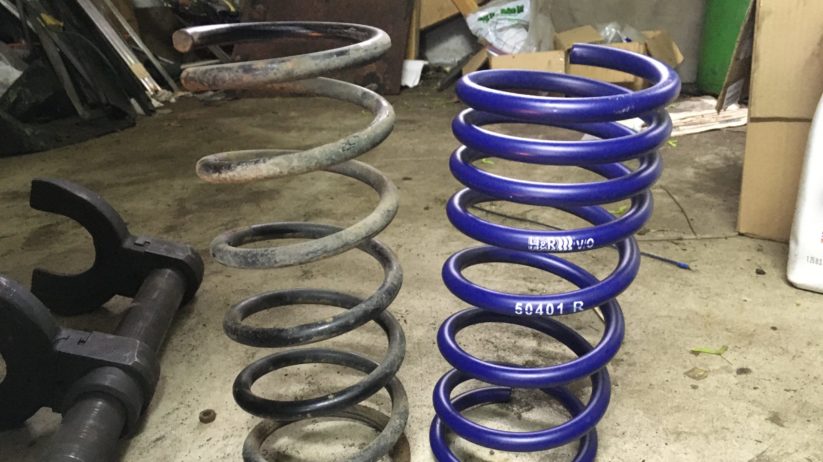On Saturday, May 16, when the Vintage was supposed to be happening in Asheville before it was postponed due to the coronavirus pandemic, I went to the Nor’East 02ers “Spring Drive (with Precautions)” in Portsmouth, New Hampshire. Seeing my regular Vintage traveling companions Andrew Wilson, Jose Rosario, and Bob Sawtelle was great, and hanging out with about twenty other 2002 heads (with masks and appropriate distance) was a joy.
We met in the parking lot of a Mexican restaurant where we’d ordered take-out the night before, ate in our cars parked two spaces apart with the windows down for social-distanced chatting, then went for a 30-mile drive, about half of which was along the New Hampshire coast, and the other half inland. The drive ended in the parking lot of the now-gone Bavarian Autosport, site of the annual fall Show-and-Shine. It was a lovely bit of symmetry, and just what the doctor ordered. Thanks to Gary Hamilton for organizing it and planning out the route.
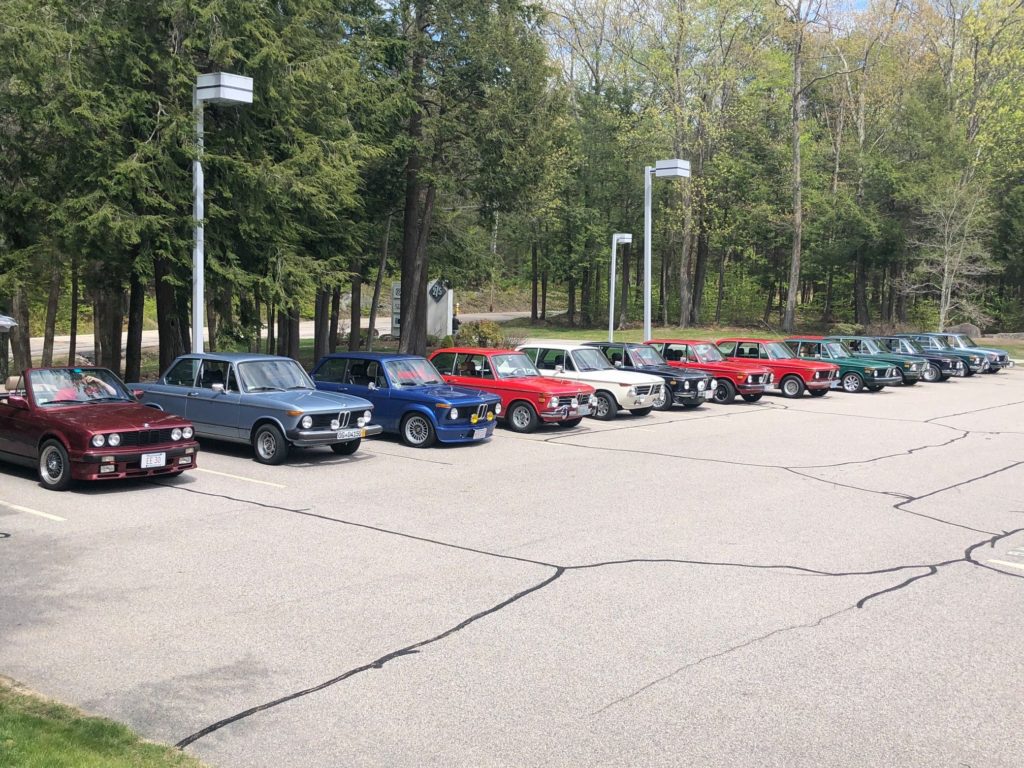
The Nor’East 02ers “Spring Drive (with Precautions)” was the perfect consolation prize for not being at the Vintage. Had this been the Bavauto “Show and Shine,” you would’ve needed to arrive at 4:00 a.m. to get these spots! :^)
An additional benefit was that it gave me the chance to blow the cobwebs off Louie, my Agave ’72 2002tii that’s the subject of Ran When Parked.
You may recall the whole saga in which Louie was in the BMW CCA Foundation museum for eleven months as part of the “2002 Icon” exhibit, I went down to get him in February 2019 and drive him back, only to be scared off by a blizzard that’d moved into the Northeast (my wife reported that I wouldn’t even be able to get the car down the driveway and the garage door open due to the amount of snow). Lance White took pity on me and trucked the car up to his place in Cincinnati, where it sat until I grabbed it on the way home from Oktoberfest 2019, only to find that the crack at the top rear corner of its head had yawned open and was dumping oil onto the exhaust manifold.
I fixed it with J-B Weld and drove it home.
Now it had been sitting in the garage since I pulled it in in near the end of last October. I planned to source a replacement head and install it, but that never happened, largely because I worked on the Lotus Europa all winter. But as we emerged into this pandemic landscape, where I’m using the cars differently (multi-day road trips, no; pleasure drives, yes), the idea of simply continuing to use Louie as-is, as long as the crack repair holds, has a lot of appeal.
So I woke Louie from his winter beauty sleep, ran him around the block a few times, verified that the crack was still sealed, and found nothing obviously wrong except that, compared with the Lotus, the steering and suspension felt like a ’69 Chrysler Imperial. While anything feels sluggish when measured against the slot-car Europa, Louis was in fact still wearing his original 48-year-old shocks and struts. His somewhat floaty boaty feel never really bothered me, because he’s a very original survivor tii, and because for years, if I wanted to drive an 02 hard, I could use Kugel, my other ’72tii—the one with with Bilstein HDs, lowering springs, fat sway bars, and camber plates—or Bertha, the ’75 2002 which still has the full-on molar-jarring Koni suspension I installed 35 years ago.
However, Kugel is gone (sold last fall), Bertha’s out in Fitchburg in one of the rented garage spaces, and a number of factors began whispering in my ear that it was time to love up Louie’s suspension a little.
Now, I’ve had a set of used Bilstein HD shocks and struts sitting on a shelf in the back of the garage for two-and-a-half years. They were given to me by my Internet friend Chris Roberts who pulled them out of a parts car he was breaking up. HDs for 2002s have been out of production for several years, so these have been like a special bottle of wine I was waiting for the right occasion to open.
As you probably know, to replace front strut cartridges, the entire strut assemblies normally need to come out, the springs have to be compressed, the tower bushings that hold in the springs have to be removed, then the bushings and springs withdrawn. So if you’re thinking about maybe changing to shorter or stiffer springs, that’s the time. For decades I’ve shied away from replacing springs, preferring the combination of stock springs, Bilstein HD shocks and struts, and thicker sway bars, but these days, judging from posts on bmw2002faq.com and the Facebook 2002 page, you need to make a lawyer’s argument to use any combination except H&R 50401 progressive-rate lowering springs and HDs.
I was musing about this at the Nor’East 02er drive, and Andrew Wilson said that his drop-dead-gorgeous ’73tii, Vern, has that combination, and I was more than welcome to take it for a spin. What I got out of the short drive was that it satisfied my concerns that the combination wasn’t even close to being overly stiff.
I searched online and found that, of all places, the Tire Rack had the best price on the H&R springs for $237 taxed and shipped. Plus, I remembered that I had a rebate Mastercard from my cancelled Verizon account with $70 on it that I could throw at it, and such things always feel like free money. I placed the order and the springs were on their way.
Reading on bmw2002faq, I learned that, unless you replace the original one-dot or two-dot rear rubber perch spacers with the taller three-dot spacers (or repurpose your old aluminum headlight spacers to put above the rubber perch spacers), the rear will sit a little too low, so I had Paul Wegweiser at Maximilian send me a pair of three-dot spacers.
I agonized a bit over the issue of sway bars. These days, the Suspension Techniques 52000 front and rear set is a fairly steep $339 everywhere, and that just felt like too much money. And compared with the free shocks and struts and the reasonable springs, that felt awfully steep. Fortunately, unlike the springs, the sway bars don’t need to be removed in order to replace the shocks and struts, so they can be replaced anytime. I left them alone for now.
Something else kind of cool, though, factored into the project: Years ago, I wondered whether it was possible to compress the front springs without removing the strut assemblies from the car. On the one hand, it’s not that big of a deal to remove the three 14-mm bolts holding the bottom of the strut to the steering knuckle, but on the other hand, on cars that still have the original safety wire through the bolts, I hate to cut the wire, and if one of those 14-mm bolts breaks, you’re in a world of hurt.
You don’t need to remove the rear springs to replace the rear shocks, but if you do want to replace the springs, normally you need to undo the half-axles in order to let the the rear trailing arm swing low enough to withdraw the spring. I have several different compressors, and found that none of them let me compress any of the springs in place, either because they simply wouldn’t fit or because their threaded portions extended upward. However, I learned of a newly-available style of compressor with two plates on a single threaded shaft, where the nut that you turn to squeeze the plates together is at the bottom, and where the lower plate moves upward, making it sound like in-place spring compression is possible. One such model can be seen on Amazon here. I found one locally on Facebook Marketplace for half price and snagged it.
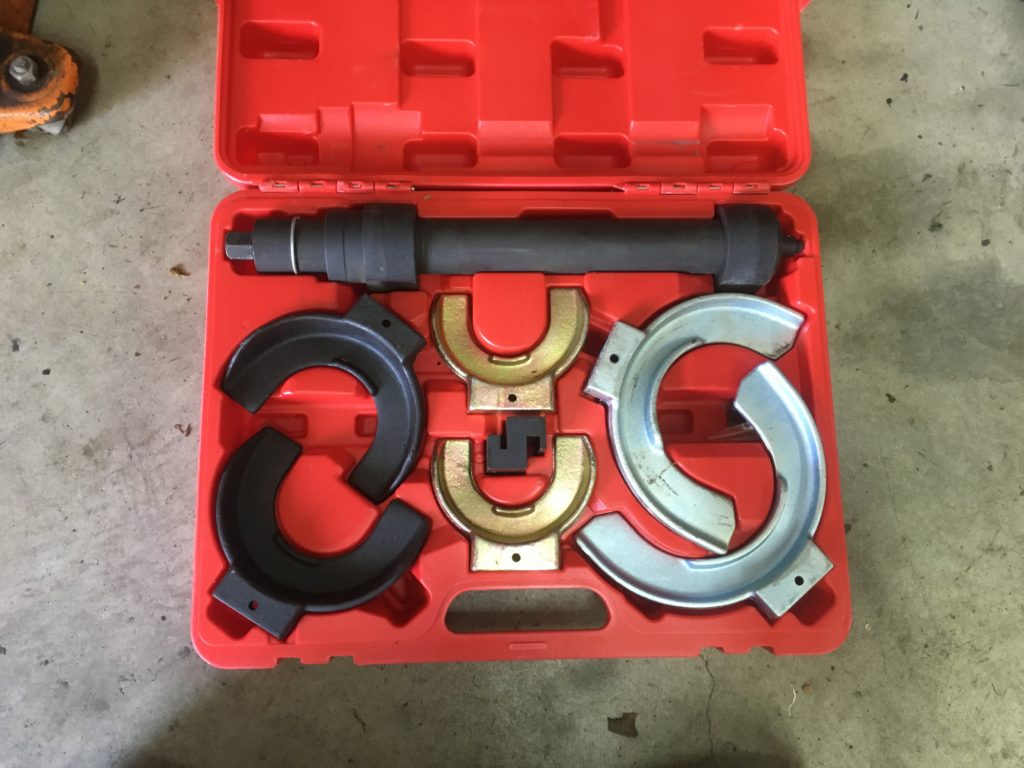
Mine!
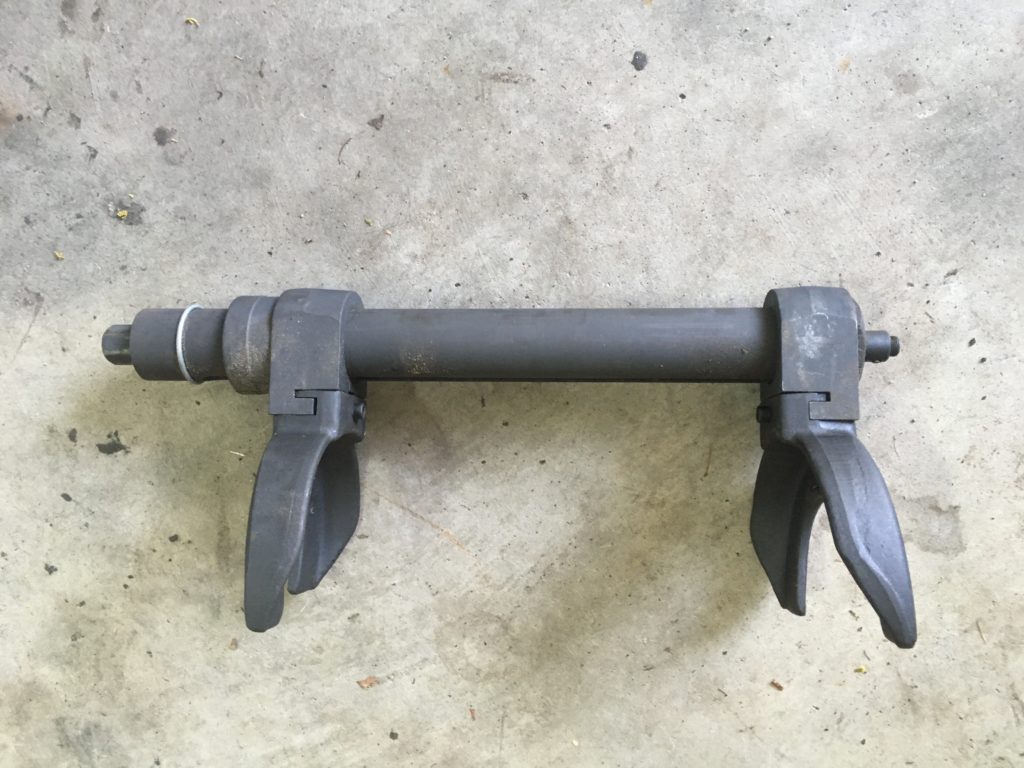
The appeal of this design is that the nut you turn to squeeze the plates together is on the bottom (on the left), and the lower plate moves upward, making it at least possible that it can be used to compress a spring from underneath the fender.
And so the Great Louie Suspension Refresh began.
I successfully used the new compressor to compress the front springs in place. Disconnecting the front sway bar end links so the lower control arms could pivot lower, forcing the steering knuckle down with my foot, and taking extreme care not to scratch the underside of the fenders with the threaded fasteners on the tops of the shock towers, I was able to swing the top of the strut assemblies out from under the fenders, undo the strut tower bushing, and withdraw the spring.
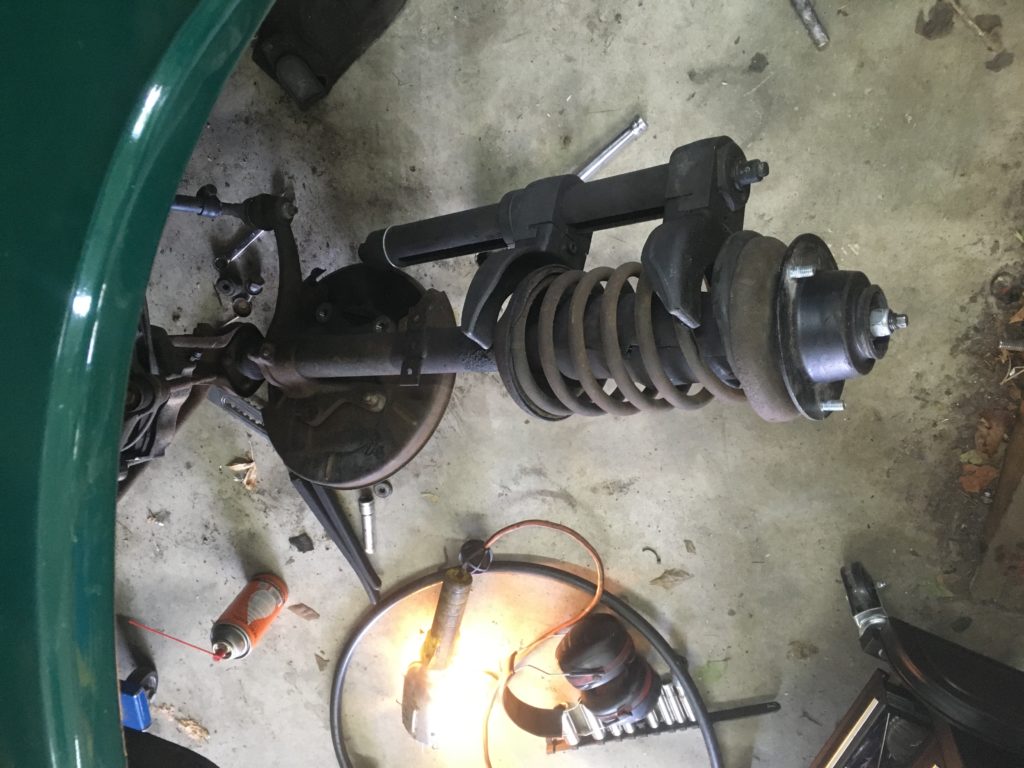
Compressing the spring enough to swing the top of the strut assembly out from under the fender.
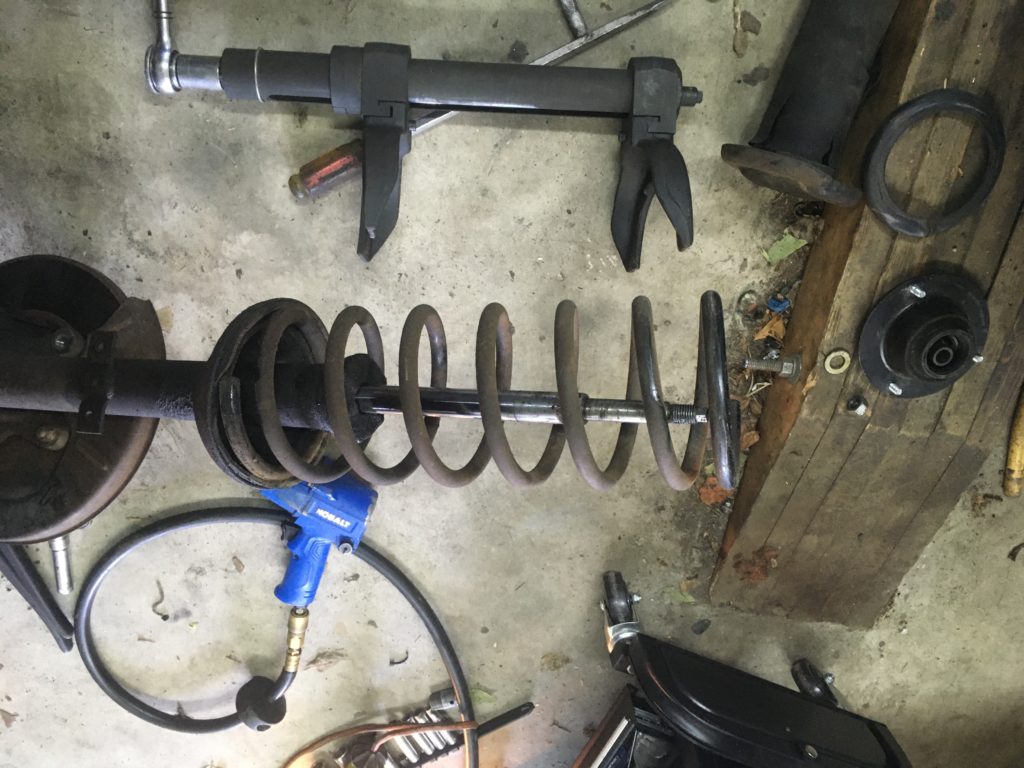
Withdrawing the spring.
Now, this in-place removal would be for naught if I couldn’t get the gland (collar) nut holding the strut cartridge in. I usually use two pipe wrenches—one on the housing and the other on the nut—and quite a bit of heat to get the nut off, and even with the assembly removed and lying on the cement, you often need to apply a back-straining amount of leverage. Fortunately, the gland nuts on both sides gave it up without my feeling like I was going to twist the ball joints out of their sockets. When I pulled the strut cartridges out, they revealed what I expected: The car still had the original oil-filled dampers.
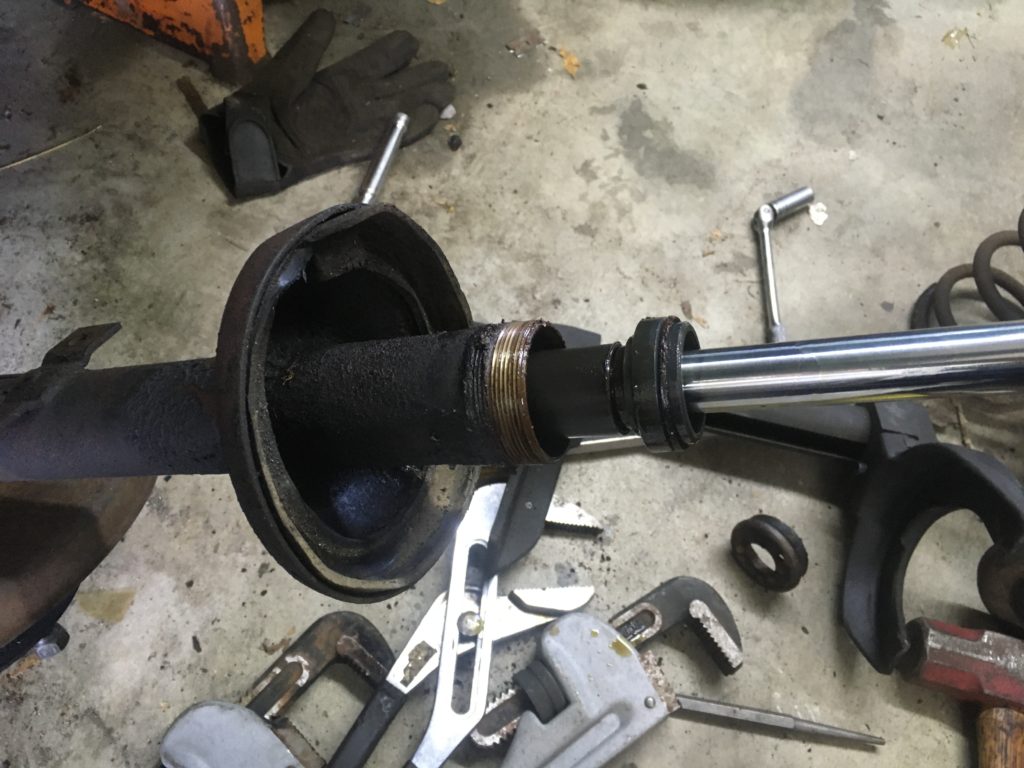
Yup, been in there since 1972.
I then pulled the used Bilstein HDs off the shelf in the back of the garage where they’d been sitting since Chris Roberts sent them to me around Thanksgiving 2017. I slid one of the strut cartridges into driver’s-side housing and realized that I had a problem: Bilsteins use their own special gland nut to hold them, and these were nowhere to be found. I looked back in my correspondence with Chris and found a photo of the shocks and struts before he sent them to me, and sure enough, the gland nuts weren’t in the picture. I hated to bother Chris about something missing from a valuable set of shocks he’d sent me at no cost, so I hunted online. I found references to the gland nut on bmw2002faq but no part number. I contacted Bilstein directly, and within a few hours, they e-mailed me sayin, “Part E4-B30-627A1 is not currently stocked in our US warehouses. We do not sell direct to the public, so you may want to inquire with some of our distributors like ECS Tuning, FCP Euro, or Summit Racing to see if they can facilitate ordering a replacement from our German facility.”
With no other option, I contacted Chris and asked him if perchance he had the gland nuts. “Let me have a look around my garage and see if those come up. To be honest, I think I might have used them as part of my homemade bushing compressor, since they were just the right diameter, heh heh… don’t think I damaged them, though.” A few minutes later he sent me this photo:
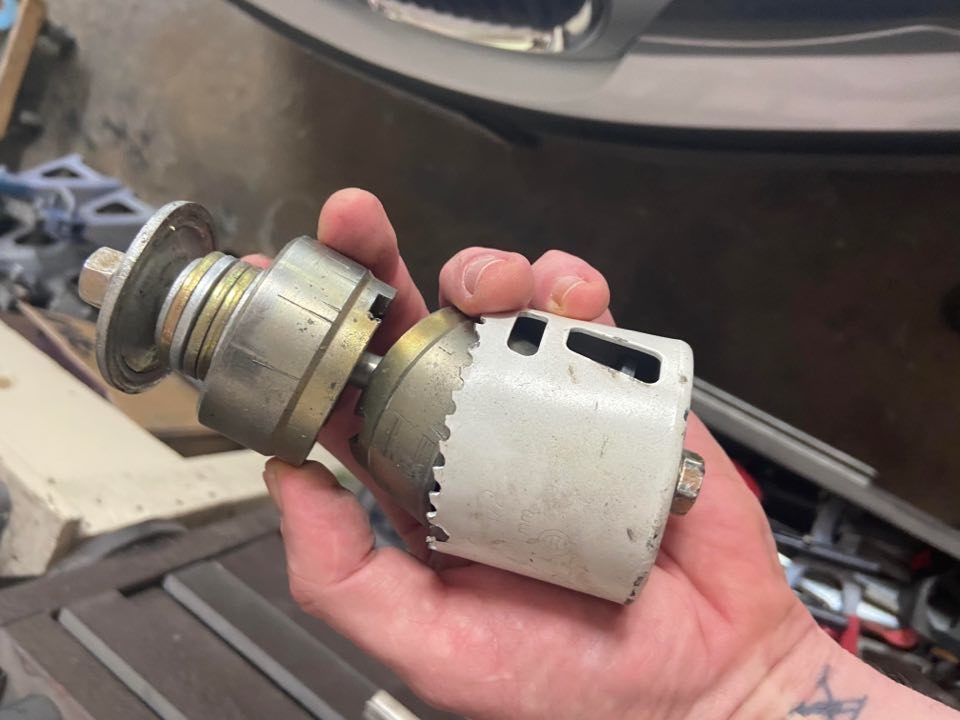
Glad that the gland nuts were used as part of a worthy cause :^)
I thanked Chris profusely, and in a few days the gland nuts arrived. I threaded on the first one, and reassembled the strut.
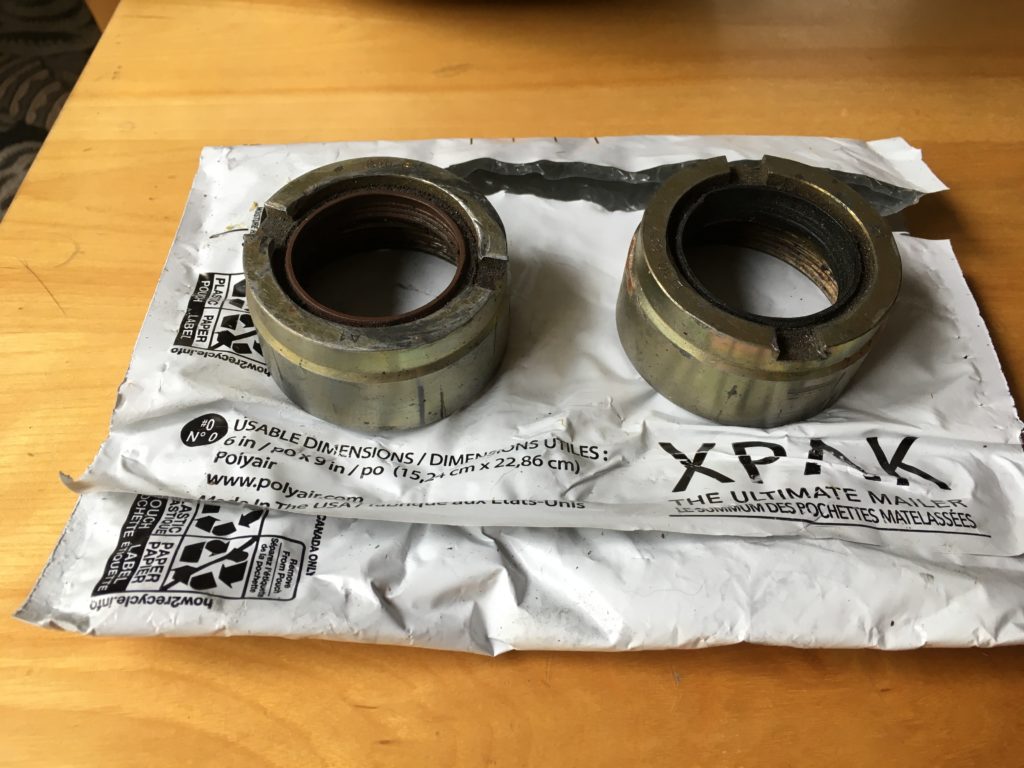
I needed deez nutz.
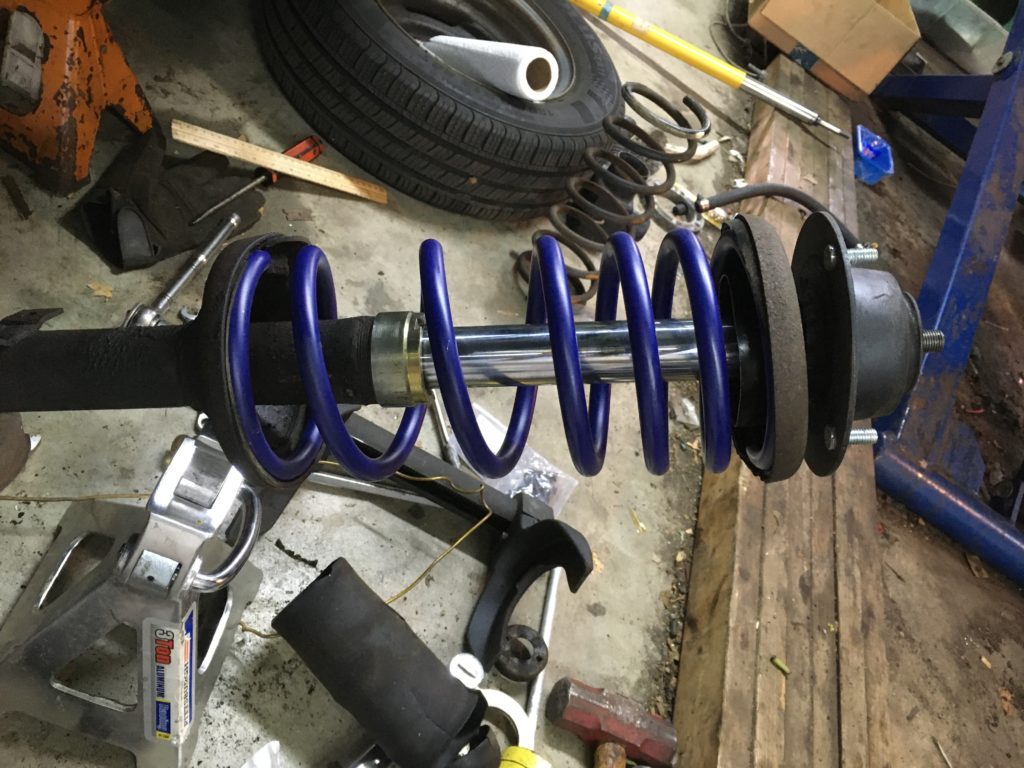
The reassembled strut waiting to be swung back into position.
But when I compressed the spring and tried to swing the assembly back under the fender, there was a problem. Unlike the original fluid-filled struts and shocks, the Bilsteins are gas-pressurized cartridges, which means that they naturally extend upward. That doesn’t change when you squeeze the spring with the compressor; it’s the weight of the car that shoves the strut tower bushing and the piston down. Because of this, in addition to compressing the spring, I wound up needing to wrap a ratchet strap from the steering knuckle up to the strut-tower bushing and strap it down to keep it from extending upward so I could get it back under the fender.
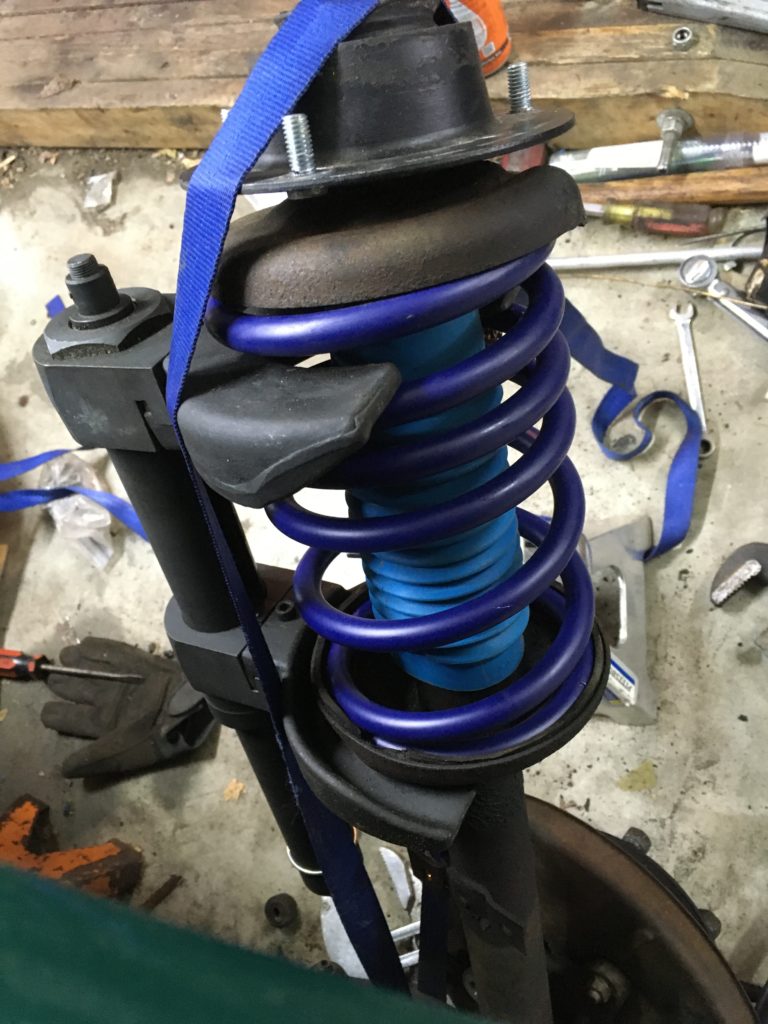
The ratchet strap is NOT being used to compress the spring—only to keep the damper piston from extending.
And… it worked fine.
Once I maneuvered the bushing under the fender and got the assembly vertical, I undid the strap and decompressed the spring. Still, if you have any concern whatsoever about possibly scratching the undersides of the fenders, it’s safer to remove the entire front strut assemblies to change the struts and springs.
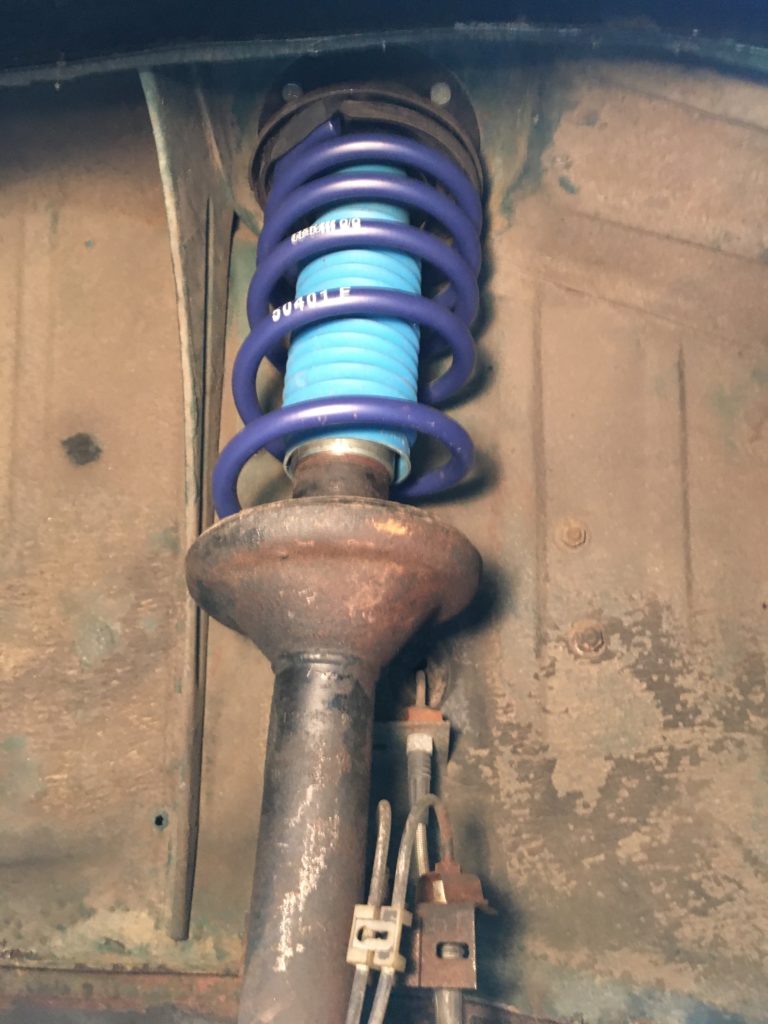
One down.
I retrieved the second strut cartridge from the shelves and immediately found a problem: The dust-cover boot wasn’t on it. I hunted around in my disaster of a garage but could not find it. I again consulted the original photo Chris had sent me, and it clearly showed all four bellows, but lost is lost. I sighed, kicked myself for my tendency to be overly linear about things (that is, I should’ve closely inspected both front struts and both rear shocks to make sure no parts were missing before starting the project), and ordered the bellows from Summit Racing. $24 and four days later, it arrived. But then, when I began installing the passenger-side strut cartridge, I had some trouble threading the second gland nut onto the housing. Careful inspection showed that the starting portion of the thread had been damaged from its brief apprenticeship as a bushing extractor. An hour spent carefully re-cutting the thread with the tip of a small, sharp chisel brought it back into compliance. I got the right side installed and buttoned up the front end.
On to the rear. I jacked up the back of the car , pulled the wheels off, and yanked out the original shocks. I then tried my newly-acquired spring compressor on the rear springs, and it worked like a charm, compressing them enough to allow me to withdraw them without having to unbolt the half axles to lower the trailing arms. On the one hand, with an impact wrench, undoing the six Allen-head nuts on each side goes quickly, but there’s always the possibility of stripping the hole or snapping off the bolt. This is a much better method.
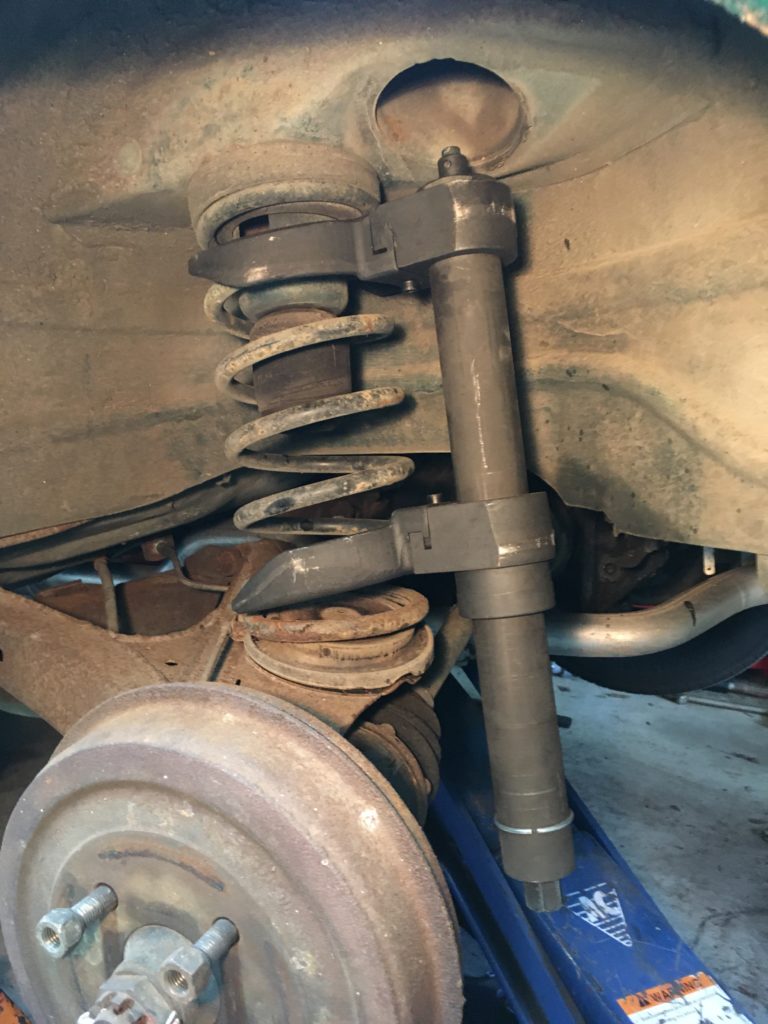
My new compressor was the perfect tool for removing the rear springs.
I then replaced the original two-dot rubber spacers with my newly-procured three-dot ones.
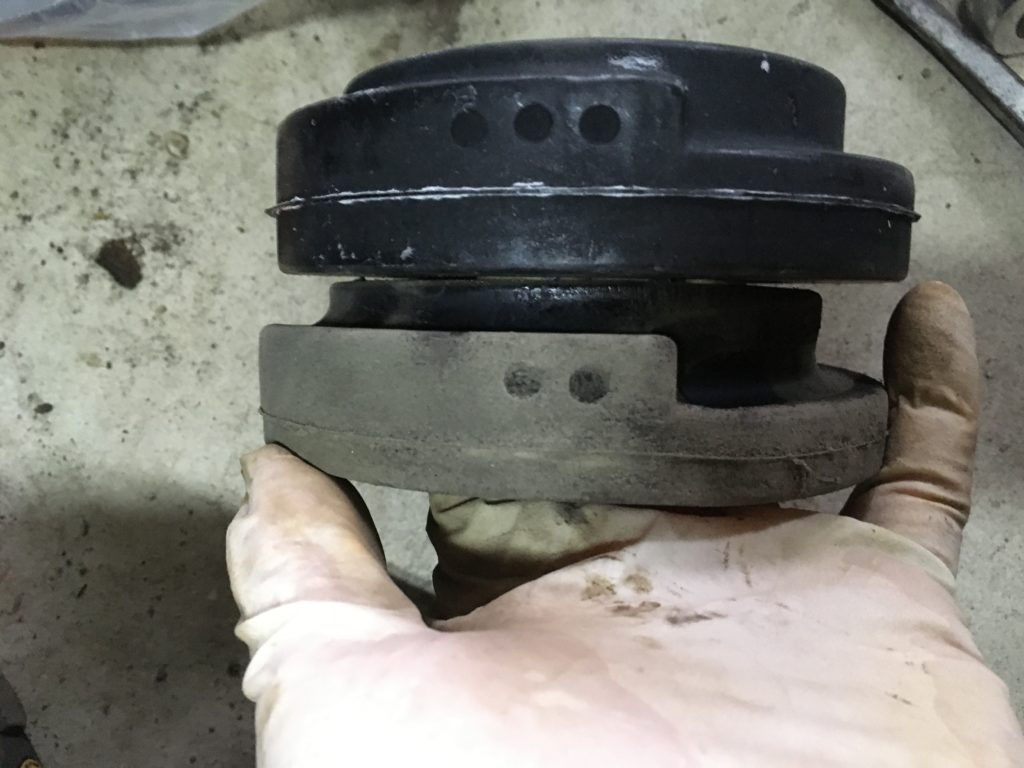
The original two-dot (bottom) and thicker three-dot (top) rear spacers.
Installing the rear H&R progressive-rate springs was a little more challenging than removing the stock ones, as the tighter coil spacing at the top was too narrow to get the plate of the spring compressor into, and even when inserted further down, the little ridge in the plate that’s there to ensure that the spring doesn’t pop out made the compressor challenging to withdraw. But still, this beat the hell out of disconnecting and reconnecting the half axles.
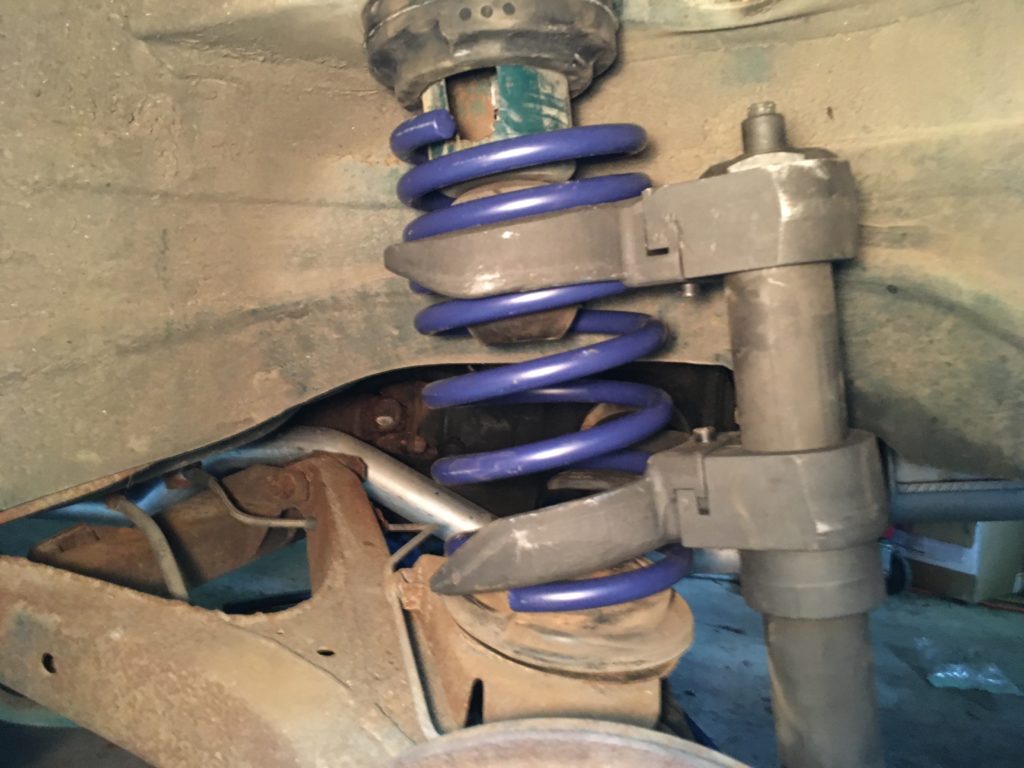
The H&R springs’ narrow upper coil spacing made this slightly more challenging.
With the springs in, I then went to install the rear Bilstein shocks, and encountered two problems. The first was that the metal insert in the bottom rubber bushing was missing. I figured that I could probably just buy one at the local hardware store. But the other problem was that the plastic boot was just flopping around unsecured. I compared it with the one on the other rear shock, and found that there was supposed to be a metal spacer with a groove in it that ridges in the plastic boot snapped into. (What was it I just said above about my tendency to be overly linear?) Even though there was no deadline or timetable, I hated the idea that I’d probably just put another four-day delay into the project.
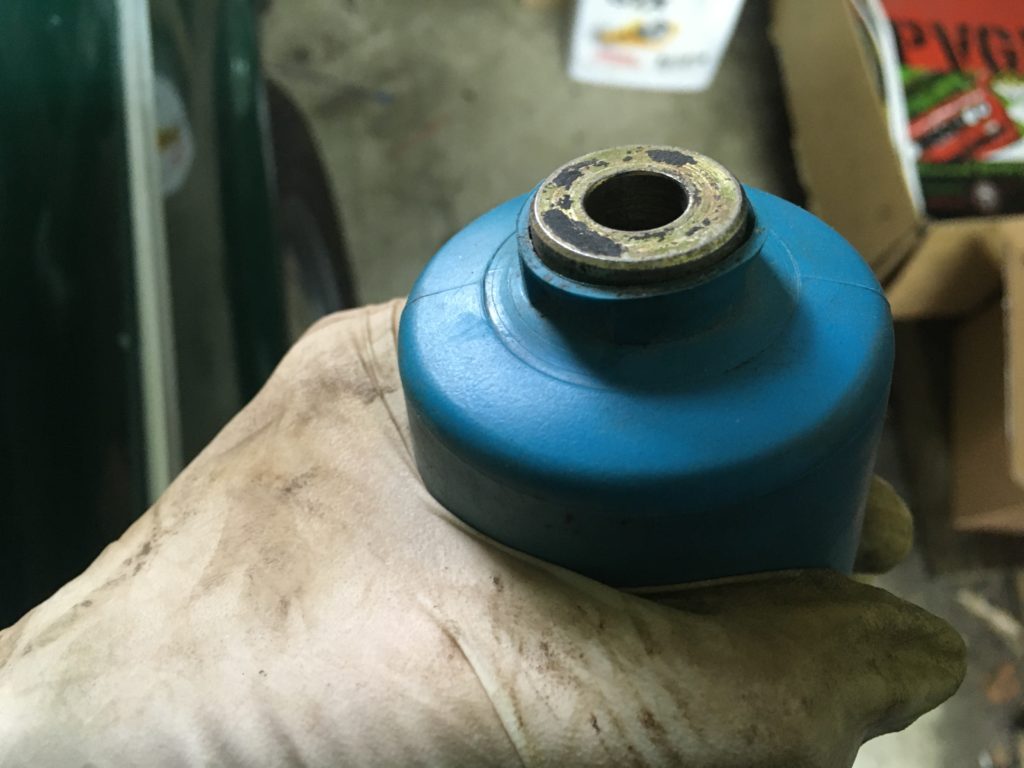
This metal spacer was missing from one of the rear boots.
I pounded the Interwebs, but to my surprise, I could find no reference whatsoever for this spacer. Without a lot of other options, I masked and gloved up, and went to the local Ace hardware store to see if I could match something up. To my delight, I found a spacer that was a perfect fit, and inserts for the bottom bushings as well. It was one of those “god bless having a well-stocked local hardware store where I can walk in with a Bilstein shock and boot and try things on for size” moments. I cut three notches in the top spacer with a Dremel tool and snapped it into place in the plastic boot, and pressed the metal sleeves into the rubber bushings.
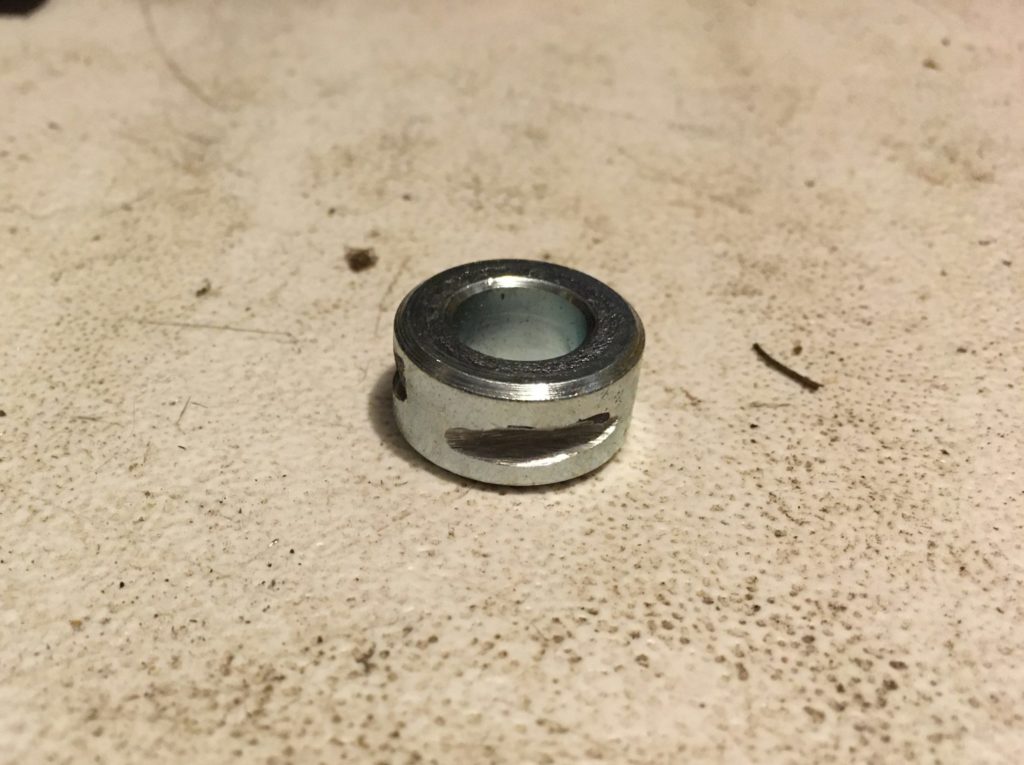
Cutting notches in the spacer with a Dremel tool.
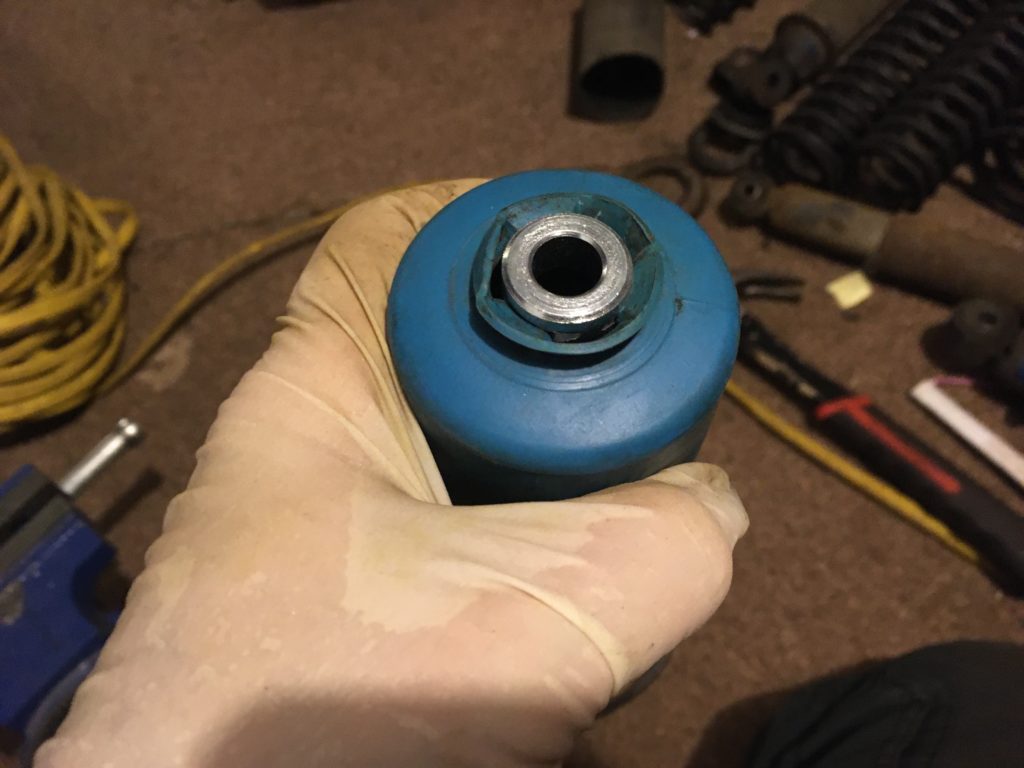
The tabs in the plastic boot snapped into the notches. Man that felt good.
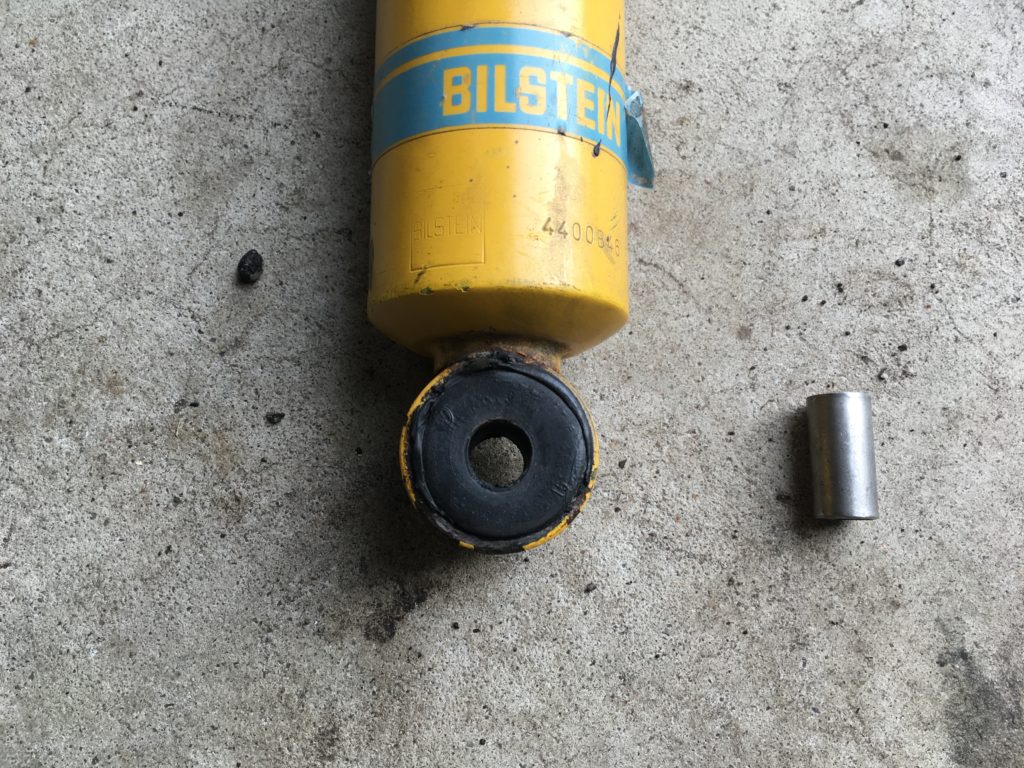
The hardware store also had metal inserts that fit the rubber bushings at the bottoms of the shocks.
I installed the rear Bilsteins, got the car down, and took it for a quick spin. Boy, I like it a lot!
Progressive-rate springs have a reputation for giving a good around-town ride and firming up when pushed. I haven’t pushed them yet, but a short drive on local roads revealed that the floaty boaty feeling is gone. One end of my street is partially ripped due to a pipe being replaced; I need to drive the Lotus over it at 15 mph. Louie’s new suspension just ate it up without any discomfort whatsoever. I’m sure that when I toss it around a junction ramp I’ll find that the body lean could still benefit from bigger sway bars, but I still have Bertha if I really want to carve corners.
The H&R 50401 package is marketed as “lowering springs.” Visually, the lowering effect on my car is very subtle. I’m not seeing the advertised 1.25″ drop, but that’s okay. I didn’t install the springs to slam it, and it’s not like it was showing ridiculous amounts of wheel well before. Plus, it may settle down a bit with use. This was the car before:
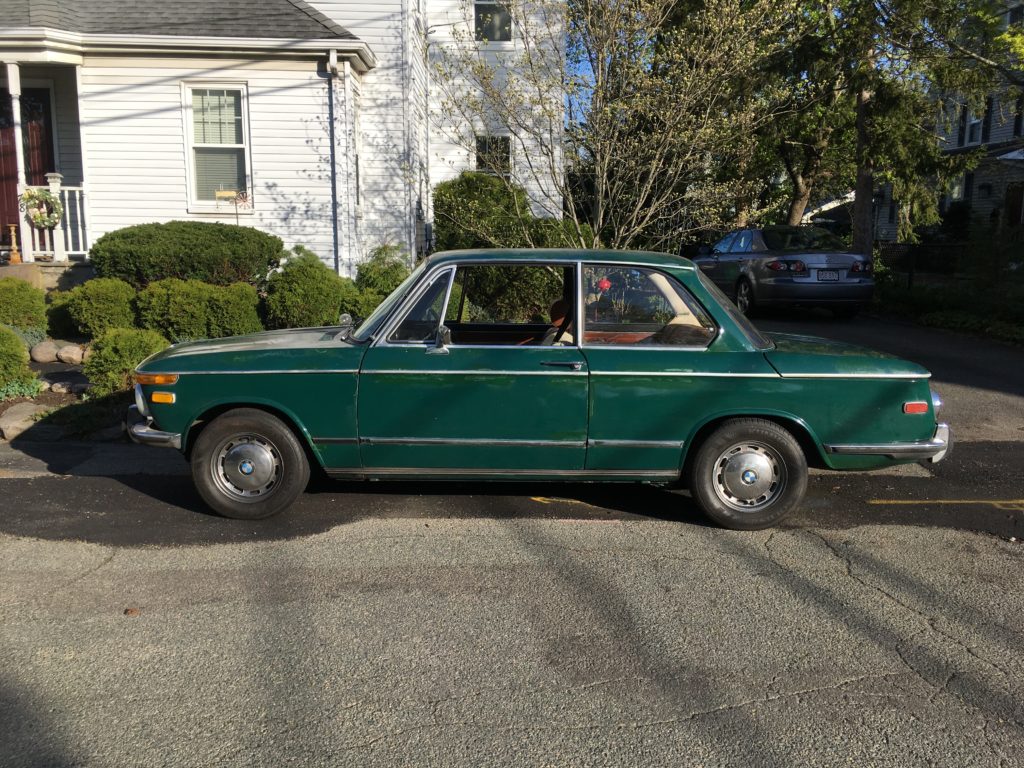
Louie on his original springs and shocks.
And this was after:
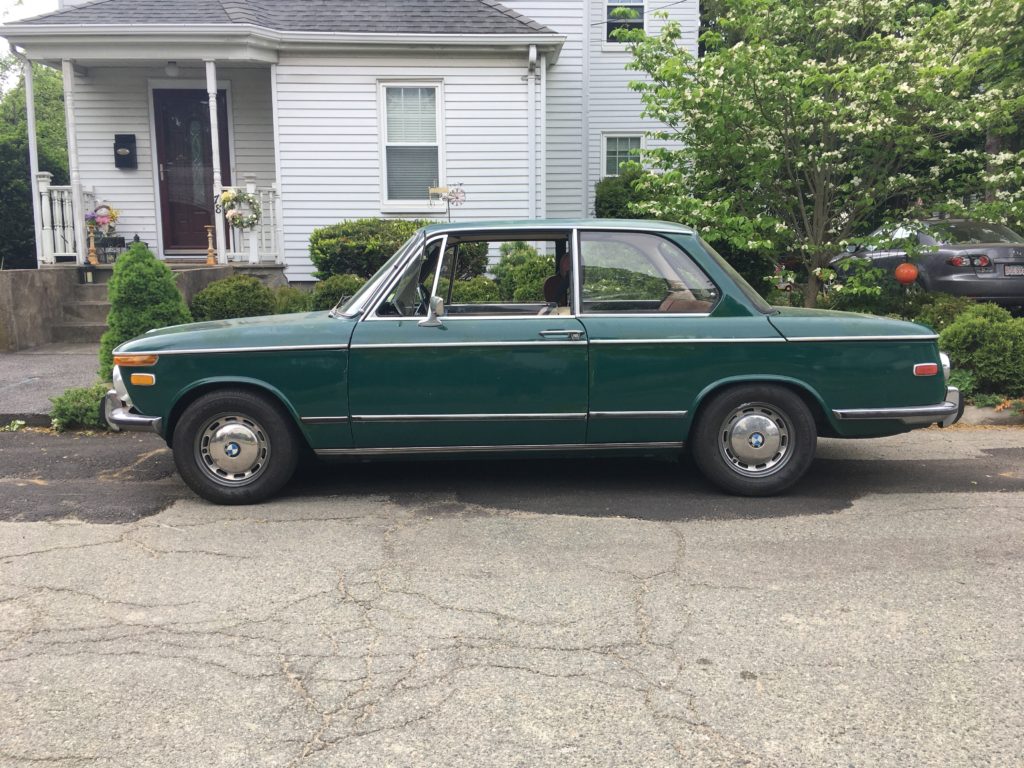
Louie on the H&R springs and Bilstein HDs.
So, not bad. As I said, I was fortunate to have been given the Bilstein HDs several years back by Chris Roberts. $237 for the H&R 50401 spring set, $50 for the used spring compressor, $24 for the missing strut boot, $10 in hardware store bits. You know what? I just noticed that the receipt that came with that Bilstein boot I bought from Summit Racing has a coupon code for $20 off the next order over $100. Hey, they carry the Suspension Techniques 52000 sway bar set….—Rob Siegel
Rob’s most recent book, Resurrecting Bertha: Buying Back Our Wedding Car After 26 Years In Storage, is available on Amazon here. His other books, including Just Needs a Recharge: The Hack MechanicTM Guide to Vintage Air Conditioning, are available here on Amazon. Or you can order personally-inscribed copies of all of his books through Rob’s website: www.robsiegel.com. His new book, The Lotus Chronicles, will be available in the fall.

